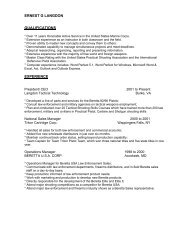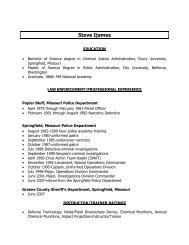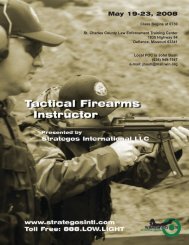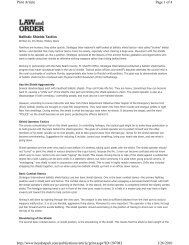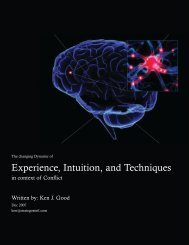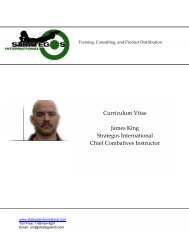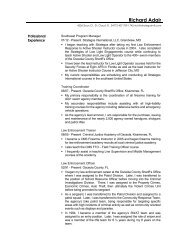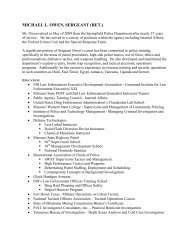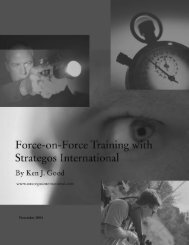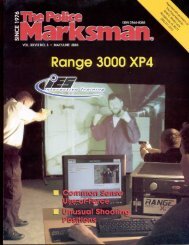Got a Second? - Strategos International
Got a Second? - Strategos International
Got a Second? - Strategos International
You also want an ePaper? Increase the reach of your titles
YUMPU automatically turns print PDFs into web optimized ePapers that Google loves.
oad to a now cached experience. The experience will be real enough to prevent<br />
disorientation when actual combat is faced.<br />
Consistent with the personal computer example, you are giving your brain upgrades specific<br />
to orientation. A larger cache of stored experiences on the hard-drive, a faster CPU,<br />
memory, and data transfer rate, greater display size, resolution and color. You now have a<br />
greater probability of arriving at a sound solution in a shorter period of time.<br />
I have spoken with numerous law-enforcement officers and military personnel following<br />
firefights on the street and in combat who have participated in good force-on-force training<br />
prior to the real thing. They were not disoriented, quite the opposite. They could articulate<br />
the details of the engagement and followed a logical and effective sequence of events<br />
during the engagement.<br />
Since all participants in the engagement must move through the OODA cycle to achieve<br />
consistent and repeatable results, you must strive to disorient your opponent. Note I<br />
did not say, out shoot, out run, out shout, the prime directive is to disorient your opponent.<br />
Once in this state, he or she should be overcome by events as you move smoothly on to the<br />
next phases and around the clock again and again. The opponent’s perception of time<br />
becomes distorted, incoming data is dismissed, decisions are irrational, and actions become<br />
erratic and ineffective. This is an immensely powerful and often overlooked tactical tool.<br />
You should have no sense of hurrying or waiting. You should be in harmony with what is<br />
actually happening.<br />
Decide – The Pipeline - The Third Quarter<br />
Practical decision-making can easily divided into two basic paths. The subconscious mind<br />
which can process hundreds of variables simultaneously, in parallel and the conscious mind<br />
which works in serial or sequentially, handling seven plus minus two variables before<br />
disregarding or misinterpreting incoming data.<br />
Any process that must be accomplished in a compressed time frame should be relegated to<br />
the powerful subconscious mind, through training.<br />
“If you consciously try to thwart opponents, you are already late”<br />
- Miyamoto Musashi<br />
Japanese Philosopher/Warrior - 1645<br />
Subconscious decisions are decisions arrived upon based on what we perceive, how we<br />
orient that perception and the time allowed to make the decision. If the threat is close and<br />
the time frame compressed we will automatically default to the sub-conscious pipeline.<br />
Whatever we brought to the situation, genetics, personality, training, assumptions, tools<br />
available, will pour out of us without conscious thought or effort.<br />
I frequently use an example based on a real world incident in Southern California. A police<br />
officer has pulled over a motorist on the roadway to issue a traffic citation. Starting off, the<br />
officer does everything correctly. He finishes his initial assessment and begins to approach<br />
the vehicle to make contact with the driver.<br />
As he makes visual and verbal contact, the driver reaches down between his legs to grab a<br />
handgun, with full intention to shoot the officer. The officer has just entered the OODA



